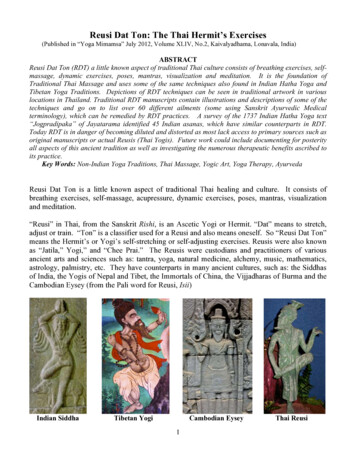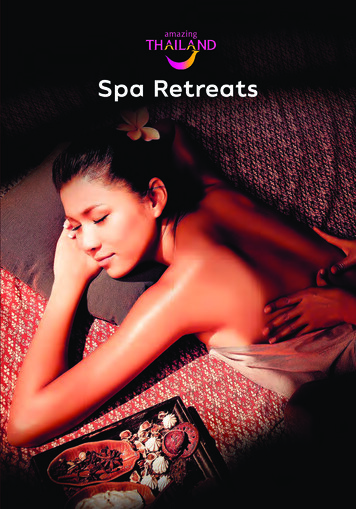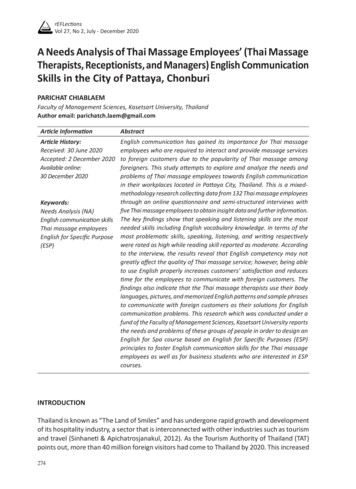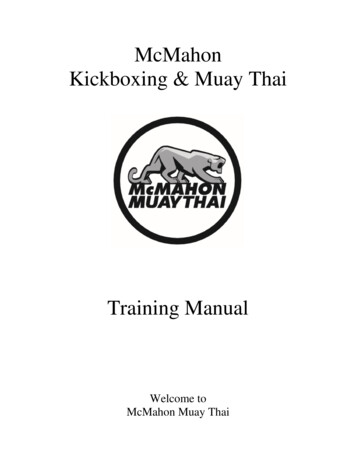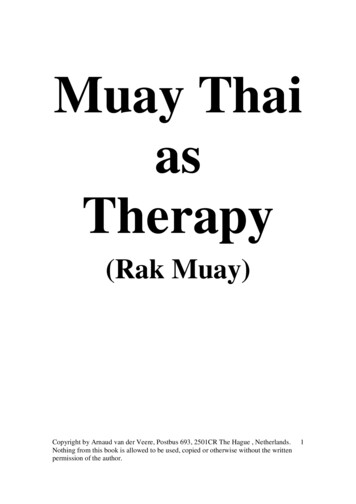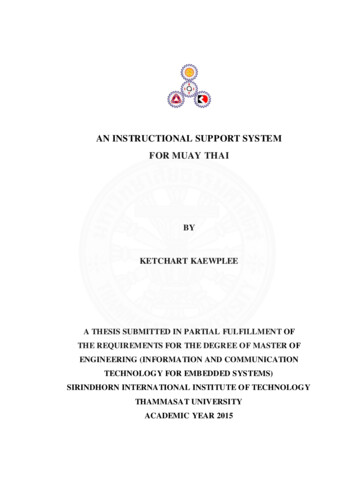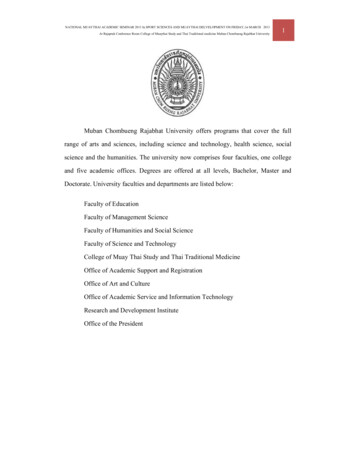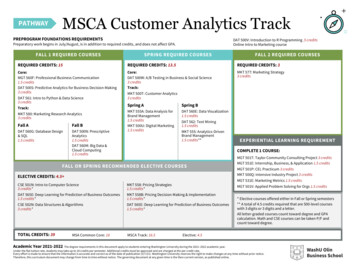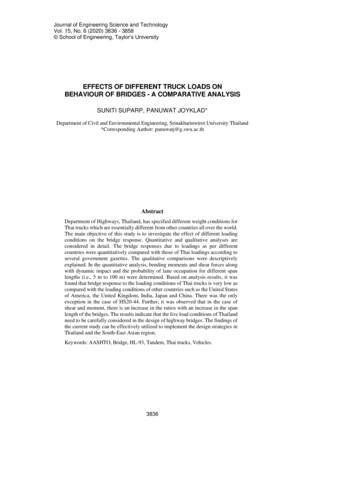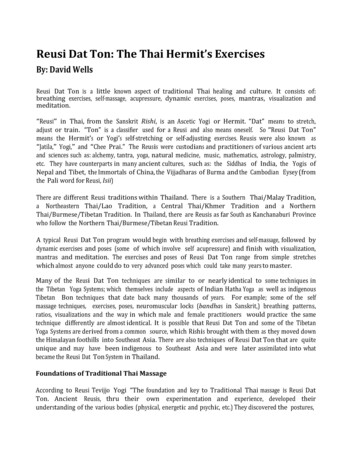
Transcription
Reusi Dat Ton: The Thai Hermit’s ExercisesBy: David WellsReusi Dat Ton is a little known aspect of traditional Thai healing and culture. It consists of:breathing exercises, self-massage, acupressure, dynamic exercises, poses, mantras, visualization andmeditation.“Reusi” in Thai, from the Sanskrit Rishi, is an Ascetic Yogi or Hermit. “Dat” means to stretch,adjust or train. “Ton” is a classifier used for a Reusi and also means oneself. So “Reusi Dat Ton”means the Hermit’s or Yogi’s self-stretching or self-adjusting exercises. Reusis were also known as“Jatila,” Yogi,” and “Chee Prai.” The Reusis were custodians and practitioners of various ancient artsand sciences such as: alchemy, tantra, yoga, natural medicine, music, mathematics, astrology, palmistry,etc. They have counterparts in many ancient cultures, such as: the Siddhas of India, the Yogis ofNepal and Tibet, the Immortals of China, the Vijjadharas of Burma and the Cambodian Eysey (fromthe Pali word for Reusi, Isii)There are different Reusi traditions within Thailand. There is a Southern Thai/Malay Tradition,a Northeastern Thai/Lao Tradition, a Central Thai/Khmer Tradition and a NorthernThai/Burmese/Tibetan Tradition. In Thailand, there are Reusis as far South as Kanchanaburi Provincewho follow the Northern Thai/Burmese/Tibetan Reusi Tradition.A typical Reusi Dat Ton program would begin with breathing exercises and self-massage, followed bydynamic exercises and poses (some of which involve self acupressure) and finish with visualization,mantras and meditation. The exercises and poses of Reusi Dat Ton range from simple stretcheswhich almost anyone could do to very advanced poses which could take many years to master.Many of the Reusi Dat Ton techniques are similar to or nearly identical to some techniques inthe Tibetan Yoga Systems; which themselves include aspects of Indian Hatha Yoga as well as indigenousTibetan Bon techniques that date back many thousands of years. For example; some of the selfmassage techniques, exercises, poses, neuromuscular locks (bandhas in Sanskrit,) breathing patterns,ratios, visualizations and the way in which male and female practitioners would practice the sametechnique differently are almost identical. It is possible that Reusi Dat Ton and some of the TibetanYoga Systems are derived from a common source, which Rishis brought with them as they moved downthe Himalayan foothills into Southeast Asia. There are also techniques of Reusi Dat Ton that are quiteunique and may have been indigenous to Southeast Asia and were later assimilated into whatbecame the Reusi Dat Ton System in Thailand.Foundations of Traditional Thai MassageAccording to Reusi Tevijjo Yogi “The foundation and key to Traditional Thai massage is Reusi DatTon. Ancient Reusis, thru their own experimentation and experience, developed theirunderstanding of the various bodies (physical, energetic and psychic, etc.) They discovered the postures,
channels, points, the winds and wind gates within themselves. Later it was realized that thesetechniques could be adapted and applied to others for their healing benefit, which is how Thai massagewas developed. So, in order to really understand Thai massage, as a practitioner, one should have afoundation in Reusi Dat Ton and be able to experience it within oneself and then apply it to others.It is not only the roots of Thai massage but it also unlocks the method for treating oneself andmaintaining one's own health.” (Reusi Tevijjo Yogi)It is also interesting to note that there are similarities between certain Thai massage techniquesand some of the Indian Hatha Yoga therapeutic warming up exercises (the Pawanmuktasana orwind liberating and energy freeing techniques.) There is even an advanced Hatha Yoga pose, PoornaMatsyendrasana, which compresses the femoral artery and produces the same effect as “opening thewind gate” in Thai massage. (Saraswati)Reusi Dat Ton in Traditional ArtIn Northeast Thailand, in Buriram province atop an extinct volcano sits the Ancient Khmertemple of Prasat Phnom Rung. Built between 900 and 1200AD, this temple is dedicated to theHindu God Shiva. The pediment over the eastern doorway features a sculpture of an avatar of Shivain the form of Yogadaksinamurti. According to the Department of Fine Arts “Yogadaksinamurtimeans Shiva in the form of the supreme ascetic, the one who gives and maintains wisdom,perception, concentration, asceticism, philosophy, music and the ability to heal disease with sacredchants.” Here “Shiva is dressed as a hermit with crowned headdress holding a rosary in his righthand, seated in the lalitasana position surrounded by followers. There are figures below himthat represent the sick and wounded.” (Department of Fine Arts).All over the templeone can see additional carvings of Reusis engaged in various activities. In one carving of the “FiveYogis” (or Reusis) the central figure is the God Shiva in his incarnation as Nagulisa, the founder ofthe Pasupata sect of Shivaite Hinduism. The four yogis on his sides are followers of this Pasupata sectthat is still active today in Nepal.In 1767, invading Burmese armies destroyed the old Thai capital of Ayutthaya. Soon after hiscoronation in 1782, the Thai King Rama I established a new capital in what is today Bangkok. Heinitiated a project to revive the Thai culture after the disaster of Ayutthaya. An old temple WatPotharam, (popularly known as “Wat Po,”) was chosen to become the site of a new Royal temple andformally renamed Wat Phra Chetuphon. Beginning in 1789, a renovation and expansion project wasbegun on the temple. King Rama I also initiated a program to restore and preserve all branches ofancient Thai arts and sciences including: medicine, astrology, religion and literature. As part of thisproject, medical texts from across the kingdom were collected and brought to be stored at Wat Po. TheKing also ordered the creation of a set of clay Reusi statues depicting various Reusi Dat Tontechniques.This restoration project was continued by the Kings Rama II and Rama III. As part of this work, scholarscompiled important texts on various ancient arts and sciences and created authoritative textbooks foreach of these fields. In 1832, a project was begun to etch the medical texts into marble tablets. Medicaltheories regarding the origin and treatment of disease, massage charts and over 1000 herbal formulas
were all recorded on the marble tablets. Gardens of medicinal herbs were also planted on the templegrounds. Thus, Wat Po was to become “a seat of learning for all classes of people in all walks of life”which would “expound all branches of traditional knowledge both religious and secular,” and serve as “anopen university of traditional Thai culture with a “library of stone.” (Griswold, 319-321)By 1836, the clay Reusi Dat Ton statues created by order of King Rama I had deteriorated. To replacethese, King Rama III commissioned the creation of 80 new Reusi Dat Ton statues. Each statuedepicted a different Reusi performing a specific Reusi Dat Ton technique. For each statue there was acorresponding marble tablet upon which was etched a poem describing the technique and it’s curativeeffect. These poems were composed by various important personalities of the day. Princes, monks,government officials, physicians, poets, and even the King himself contributed verses. The original planwas to cast the statues with an alloy of zinc and tin, but unfortunately only the more perishablematerial stucco was used. The statues were then painted and housed in special pavilions. Over the yearsmost of the original statues have been lost or destroyed. Today only about20 remain and these are displayed upon two small hills near the Southern entrance of Wat Po. Themarble tablets have been separated from their corresponding statues and are now stored in the pavilionSala Rai.Beginning in 2009, the casting of metal Reusi Dat Ton statues was begun. These new statues aregradually appearing in and around the Wat Po Massage School near the Easternentrance of Wat Po. So now after almost 200 years, Wat Po will soon finally have it’s complete setof 80 metal Reusi Dat Ton statues as originally envisioned by King Rama III.Textual Sources of Reusi Dat TonWe may never know what, if any Ancient texts on Reusi Dat Ton may have existed and were lost whenthe invading Burmese armies destroyed the old Thai capital of Ayutthaya in 1767. Today, the closestthing to an original source text on Reusi Dat Ton is an 1838 manuscript commissioned by Rama IIIentitled The Book of Eighty Rishis Performing Posture Exercises to Cure Various Ailments. Likeother manuscripts of the time, this text was printed on accordion like folded black paper, known inThai as “Khoi.” This text, popularly known as the Samut Thai Kao features line drawings of the80 Wat Po Reusi Dat Ton statues along with their accompanying poems. In the introduction, it statesthat Reusi Dat Ton is a “ system of posture exercises invented by experts to cure ailments and makethem vanish away.” (Griswold, 321) This text is housed in the National Library in Bangkok.There are also other editions of this text housed in museums and private collections as well.The Samut Thai Kao seems to follow an old tradition also found in ancient Indian, Nepali andTibetan Yoga manuscripts that list 80 to 84 different techniques. The Samut Thai Kao is, however,only a partial collection of all the various Reusi Dat Ton techniques. A 1958 Wat Po publication, TheBook of Medicine includes a section on Reusi Dat Ton. While it contains verses based upon the poemsat Wat Po, many of the accompanying illustrations depict completely different techniques.In the Southern Thai town of Songkhla, on the temple grounds of Wat Machimawat is a pavilionknown as the “Sala Reusi Dat Ton.” High up on the inside walls of this pavilion is a mural whichdepicts 40 of the Reusi Dat Ton techniques along with the accompanying poems from the Samut ThaiKao.
There is a special section devoted to Thai Medical history at the Mahidol University’s SirirajMedical Museum on the Bangkok Noi campus in Bangkok. There one can view a Reusi Dat Ton displaywhich features small painted wood Reusi figures that depict over 60 different Reusi Dat Ton techniques.This display is based upon the 1958 Wat Po text The Book of Medicine.In Nonthaburi, on the Ministry of Public Health Campus at the Institute of Thai TraditionalMedicine, there is the Thai Traditional Medicine Museum. Inside the museum is a small display of ReusiDat Ton statues. Outside the museum is an artificial mountain upon which have been placedvarious Reusi statues demonstrating Reusi Dat Ton techniques. Within the mountain is the“Hermit’s Cave” which houses numerous small Reusi statues also depicting Reusi Dat Ton techniques.These statues depict techniques from both the Samut Thai Kao and The Book of Medicine.On the outskirts of Bangkok, in the town of Samut Prakan, is the cultural park, the Ancient Cityor “Muang Boran.” One of the many attractions is a “Sala of 80 Yogi” which features 80 life-sized Reusistatues depicting various Reusi Dat Ton techniques. There are even depictions of Reusi Dat Tontechniques not found in either of the two Wat Po texts. While most of these statues are fairly accuratedepictions of Reusi Dat Ton techniques, a few actually depict some Indian Hatha Yoga techniques,which are not part of the Reusi Dat Ton system.Students of Reusi Dat Ton should bear in mind that while some of the Reusi Dat Don statues,drawings, paintings and poems are beautiful works of art, they were created by artists who were notnecessarily all practitioners of Reusi Dat Ton. In fact, a number of images are not entirely accuratedepictions of the actual techniques. Even in 1836, there was some uncertainty as to which techniqueproduced which effect and some poems were used for more than one technique. Therefore, students ofReusi Dat Ton should also seek out living teachers who have learned from authentic sources such asactual Reusis who can teach the techniques in their authentic form.There are also additional Reusi Dat Ton techniques practiced by Reusis today, which are not found inany text, nor depicted in any sculpture or paintings. These are also traditional techniques, whichhave been passed down from teacher to student over the centuries. In total, there are close to 200different exercises and poses, including variations, in the entire Reusi Dat Ton system.The Benefits of Reusi Dat TonIn both the Samut Thai Kao and The Book of Medicine, the texts not only describe thetechniques, but also ascribe a therapeutic benefit to each pose or exercise. Some poems describe specificailments while others use Sanskrit Ayurvedic medical terminology.Some of the ailments mentioned include; abdominal discomfort and pain, arm discomfort, back pain,bleeding, blurred vision, chest congestion, chest discomfort and pain, chin trouble, chronic disease,chronic muscular discomfort, congestion, convulsions, dizziness and vertigo, dyspepsia, facial paralysis,fainting, foot cramps, pain and numbness, gas pain, generalized weakness, generalized sharp pain,headache and migraine, hand discomfort, cramps and numbness, heel and ankle joint pain,hemorrhoids, hip joint problems, joint pain, knee pain and weakness, lack of alertness, legdiscomfort, pain and weakness, lockjaw, low back pain, lumbar pain, muscular cramps and stiffness,nasal bleeding, nausea, neck pain, numbness, pelvic pain, penis and urethra problems, scrotal distention,secretion in throat, shoulder and scapula discomfort and pain, stiff neck, thigh discomfort, throat
problems, tongue trouble, uvula spasm, vertigo, waist trouble, wrist trouble, vomiting, and waistdiscomfort.Some of the Ayurvedic disorders described in the texts include; Wata (Vata in Sanskrit) in the headcausing problems in meditation, severe Wata disease, Wata in the hands and feet,Wata in the head, nose and shoulder, Wata in the thigh, Wata in the scrotum, Wata in the urethra, Watacausing knee, leg and chest spasms, Wata causing blurred vision, Sannipat (a very serious and difficult totreat condition due to the simultaneous imbalance of Water, Fire and Wind Elements which mayalso involve a toxic fever) an excess of Water Dhatu (possibly plasma or lymph fluids,) and “Wind” inthe stomach. Other benefits described in the old texts include; increased longevity and opening all of the“Sen” (Nadis in Sanskrit or channels of bioenergy flow within the subtle body.)In recent years, the Thai Ministry of Public Health has published several books on Reusi Dat Ton.According these modern texts, some of the benefits of Reusi Dat Ton practice include; improved agilityand muscle coordination, increased joint mobility, greater range of motion, better circulation,improved respiration improved digestion, assimilation and elimination, detoxification, strongerimmunity, reduced stress and anxiety, greater relaxation, improved concentration and meditation,oxygen therapy to the cells, pain relief, slowing of degenerative disease and greater longevity. (Subcharoen,5-7)A recent study at Naresuan University in Phitsanulok, Thailand, found that after one month ofregular Reusi Dat Ton practice there was an improvement in anaerobic exercise performance insedentary females. (Weerapong et al, 205)Reusi Dat Ton TodayToday in Thailand, Reusi Dat Ton is being used in various ways. Some practice Reusi Dat Ton poses andexercises as a way to improve and maintain overall health, in much the same way as Hatha Yoga andChi Gong are used today. Others such as Ajan Pisit Benjamongkonware of Pisit’s Massage Schoolin Bangkok use Reusi Dat Ton in combination with traditional Thai Massage techniques as a systemof therapy. They will use specific techniques for specific ailments, rather like an ancient system ofrehabilitation similar to modern day Chiropractic and Physical Therapy. Others consider theenergetic effects with the aim of facilitating the normal healthy flow of bioenergy through the “Sen” orenergy channels of the subtle body. There are also a few remaining Reusis who still use Reusi Dat Tonin the traditional way as part of their personal meditation and spiritual practice.The Institute of Thai Traditional Medicine at the Ministry of Public Health requires all theirstudents of Thai Massage and Thai Traditional Medicine to attend Reusi Dat Ton classes as part oftheir curriculum. In these classes, students learn some of the self-massage techniques as well as 15 posesand exercises. While based on Reusi Dat Ton, these 15 techniques are actually newly createdmodifications thought to be safe and easily practiced by anyone. In Bangkok, The Wat Po School ofTraditional Medicine offers a formal Reusi Dat Ton certification course in which students learn 18 ofthe poses and exercises. The Massage School Chiang Mai offers a formal Reusi Dat Ton certificate course,which is accredited by the Thai Ministry of Education. Their course is based on the same 15 poses andexercises as taught by the Ministry of Public Health. There are also a number of other
places offering Reusi Dat Ton classes. Most of these programs teach either one or a combination ofboth of the two different programs, as taught by the Ministry of Public Health and Wat Po. Thereare also a number of commercially available Reusi Dat Ton books and videos.Today in Thailand, there are a dwindling number of true Reusis and few young people are interested inlearning the traditional arts and sciences in their authentic forms. Much of the traditionalknowledge of the Reusi traditions is in danger of being lost. Nowadays, most modern day studentsand teachers of Reusi Dat Ton have learned from second or third hand sources such as commerciallyavailable books, videos and classes. They have not had access to primary sources such as actual Reusis oreven the Samut Thai Kao. If this trend continues, there is a danger of Reusi Dat Ton becomingdiluted and distorted like Hatha Yoga has become in today’s popular culture. Today we may well beseeing the last generation of teachers with an actual living link to the ancient traditions of the pastand who are able to transmit the authentic teachings of Reusi Dat Ton. Serious students of ReusiDat Ton would do well to seek out actual Reusis who have themselves learned from older Reusis whoserve as a living link in the lineage of this ancient tradition.Possible Future ResearchA possible research project would be to seek out Reusis and traditional healers across Thailand.One would then learn as much as possible about Reusi Dat Ton from them and compile it. This way theauthentic teachings of this ancient tradition would not be lost in case these people die without beingable to pass their knowledge on to the next generation. It could also be well worth investigating themany claims about the therapeutic effects attributed to Reusi Dat Ton practices in the old texts.Sources and Suggestions for Additional ReadingEnglish LanguageBaker, Ian A., “The Dali Lama’s Secret Temple: Tantric Wall Paintings from Tibet.” London,Thames & Hudson Ltd., 2000.Buhnemann, Gudrun, “Eighty Four Asanas in Yoga: A Survey of Traditions,” New Delhi, D. K.Printworld, 2007.Chokevivat, Vichai and Chuthaputti, Anchalee, “The Role of Thai Traditional Medicine in HealthPromotion,” Nontaburi, Ministry of Public Health, 2005.Chuthaputti, Anchalee, “National Traditional System of Medicine Recognized by the ThaiGovernment,” Nontaburi, Ministry of Public Health, 2007.Covington, Laura, “Interview with a Reusi,” Richmond, Bodhi Tree Learning Center,2010. (Interview with Reusi Tevijjo Yogi)Department of Fine Arts, “Phnom Rung Historical Park Visitors Guide.” (And displays in the PhnomRung Museum.) Buriram, Thailand, Department of Fine Arts.
Evans-Wentz, W. Y., “Tibetan Yoga and Secret Doctrines.” Varanasi, Pilgrims Publishing,2008.Gharote, M. L. (Editor in Chief), “Encyclopaedia of Traditional Asanas.” Lonavala, TheLonavala Yoga Institute, 2006.Ginsburg, Henry, “Thai Art and Culture: Historic Manuscripts from Western Collections.” Honolulu,University of Hawaii, 2000.Griswold, A.B. “The Rishis of Wat Po.” In Felicitation Volumes of Southeast Asian StudiesPresented to His Highness Prince Dhaninivat Kromamun Bidyalabh Brindhyakorn. Bangkok: TheSiam Society, 1965.H.H. Prince Dhani Nivat, “The Inscriptions of Wat Phra Jetubon,” Journal of the SiamSociety., Vol. 26, Pt. 2. Bangkok, The Siam Society.Hofbauer, Rudolf. “A Medical Retrospect of Thailand.” In Journal of the Thailand ResearchSociety, 34: 183-200.Miao, Yuan. “Dancing on Rooftops with Dragons: The Yoga of Joy.” Los Angeles, ThePhilosophical Research Society, 2002.Massage School of Chiang Mai, Yogi Exercise “Lue Sri Dadton” Student Handbook. Chiang Mai,Massage School of Chiang Mai, 2006.Matics, Kathleen Isabelle. An Historical Analysis of the Fine Arts at Wat Phra Chetuphon: ARepository of Ratanakosin Artistic Heritage, PhD Dissertation, New York University, 1978.Matics, K.I. “Medical Arts at Wat Pha Chetuphon: Various Rishi Statues.” In Journal of theSiam Society, 65:2 (1977): 2: 145-152.Norbu, Chogyal Namkhai. “Yantra Yoga: The Tibetan Yoga of Movement.” Ithaca, SnowLion Publications, 2008.Reusi Tevijjo Yogi, Bangkok, Thailand, Personal Communication.Salguero, C. Pierce, “Traditional Thai Medicine: Buddhism, Animism and Ayurveda.” Prescott, AZ.Hohm Press, 2007.Saraswati, Swami Satyananda, “Asana, Pranayama, Mudra, Bandha.” Munger, Bihar, YogaPublications Trust, 2006.Schoeppl, Adolf. Textbook of Thai Traditional Manipulative Medicine, MPH Thesis, MahidolUniversity, 1981.Sheposh, Joel, Reusi Dat Ton: Thai Style Exercises, Charlottesville, Tao Mt., 2006.Subcharoen, Pennapa and Deewised Kunchana, (editors). “The Hermits Art of Contorting
Thai Traditional Medicine.” Nontaburi, The National Institute of Thai Traditional MedicineTulku, Tarthang, “Kum Nye Relaxation: Parts 1and 2.” Berkeley, Dharma Publishing,1978.Tulku, Tarthang, “Tibetan Relaxation: Kum Nye Massage and Movement.” London, Duncan BairdPublications, 2003.Venerable Dhammasaro Bikkhi, “Textbook of Basic Physical Training- Hermit Style(Rishi).” Bangkok, Wat Po.Wat Po Thai Traditional Medical School, Ruesi Dat Ton; Student Handbook. Bangkok, Wat Po.White, David Gordon, “The Alchemical Body: Siddha Traditions in Medieval India.” Chicago,University of Chicago Press, 1996.Thai LanguageAjan Pisit Benjamongkonware, “Twenty One Self Stretching Exercises (21 Ta Dat Ton).” Bangkok,Village Doctor Press, 2007.Ajan Pisit Benjamongkonware of Pisit’s Massage School, Bangkok, Thailand, PersonalCommunication.Ajan Kong Kaew Veera Prajak (Professor of Ancient Languages) at the Ancient Manuscript andInscription Department, National Library, Bangkok, Thailand. Personal Communication.Chaya, Ooh E., “Thai Massage, Reusi Dat Ton: Therapy for Illness and Relaxation, (NuatThai, Reusi Dat Ton: Bam Bat Rok Pai Klie Klieat.”) Bangkok, Pi Rim Press, 2006.Karen Reusi in Thung Yai National Park in Kanchanaburi Province, Thailand, PersonalCommunication via Dr. Robert Steinmetz of Wildlife Fund Thailand.Mr. Kayat, (editor), “Eighty Poses of Reusi Dat Ton, Wat Po (80 Ta Bat Reusi Dat Ton, Wat Po.)”Bangkok, Pee Wa Tin Press, 1995.Mulaniti Health Center, “41 Poses, The Art of Self Massage for Health, (41 Ta, SinlabaGan Nuat Don Eng Pua Sukapap.)”, Bangkok, Mulaniti Health Center, 1994.Patanagit, Arun Rawee, “Body Exercise, Thai Style: Reusi Dat Ton, (Gan Brehan Rang GieBap Thai: Chut Reusi Dat Ton),” Bangkok, Petchkarat Press, 1994.Saw Pai Noie, “Lang Neua Chop Lang Ya.” Bangkok, Sai Ton Press, 2001.Sela Noie, Laeiat, “Amazing Thai Heritage: Reusi Dat Ton.” Bangkok, Dok Ya Press, 2000. Subcharoen,Pennapa (editor), “Handbook of Thai Style Exercise: 15 Basic Reusi Dat TonPoses, (Ku Mu Gie Brehan Bap Thai Reusi Dat Ton 15 Ta,)” Bangkok, Thai TraditionalMedicine Development Foundation, 2004.
Subcharoen, Pennapa (editor), “One Hundred Twenty Seven Thai Style Exercises, Reusi Dat Ton (127Ta Gie Brehan Bap Thai, Reusi Dat Ton).” Bangkok, Thai Traditional Medicine DevelopmentFoundation, 2006.Various authors commissioned by King Rama III, “The Book of Eighty Rishis Performing PostureExercises to Cure Various Ailments (Samut Rup Reusi Dat Ton Kae Rok Tang Tang Baet Sip Rup).”Housed in the National Library Bangkok, Thailand, 1838. (Also known as Samut Thai Kao)Wat Po Thai Traditional Medicine School, “Reusi Dat Ton Handbook (Dam Ra Reusi Dat Ton WatPo).” Bangkok, Wat Po Press, 1990. (Reproductions from the original Samut Thai Kao)Wat Po Thai Traditional Medicine School, “The Book Of Medicine (Dam Ra Ya),” Bangkok, Wat PoPress, 1958. (Contains a Reusi Dat Ton section based on the same verses as the1838 manuscript, Samut Thai Kao, but with completely different illustrations.)Weerapong Chidnok, Opor Weerapun, Chanchira Wasuntarawat, Parinya Lertsinthai and EkaweeSripariwuth. “Effect of Ruesi-Dudton-Stretching-Exercise Training to Anaerobic Fitness in HealthySedentary Females.” Naresuan University Journal 2007; 15 (3) 205-214.This article is 2010 by David WellsDavid Wells , RYT 500, CAS, is a Registered Yoga Teacher and Clinical Ayurvedic Specialistwho graduated from The California College of Ayurveda. He has a degree in Biology andreceived advanced Yoga certifications from Kaivalydhama Yoga Institute, The SivanandaYoga Vedanta Center, The Yoga Institute in Mumbai and The Yoga Research Center ofRishikesh in India. He served three years in Peace Corps Thailand and studied Thai Massageat The Wat Po School of Traditional Medicine. He received Reusi Dat Ton certifications fromWat Po and The Massage School of Chiang Mai and also studied with Reusi Tevijjo Yogi andAjan Pisit Benjamongkonware in Thailand. He currently teaches Yoga in Southern California.Contact Information: www.wellsyoga.com
means the Hermit’s or Yogi’s self-stretching or self-adjusting exercises. Reusis were also known as “Jatila,” Yogi,” and “Chee Prai.” The Reusis were custodians and practitioners of various ancient arts and sciences such as: alchemy, tantra, yoga, natural
